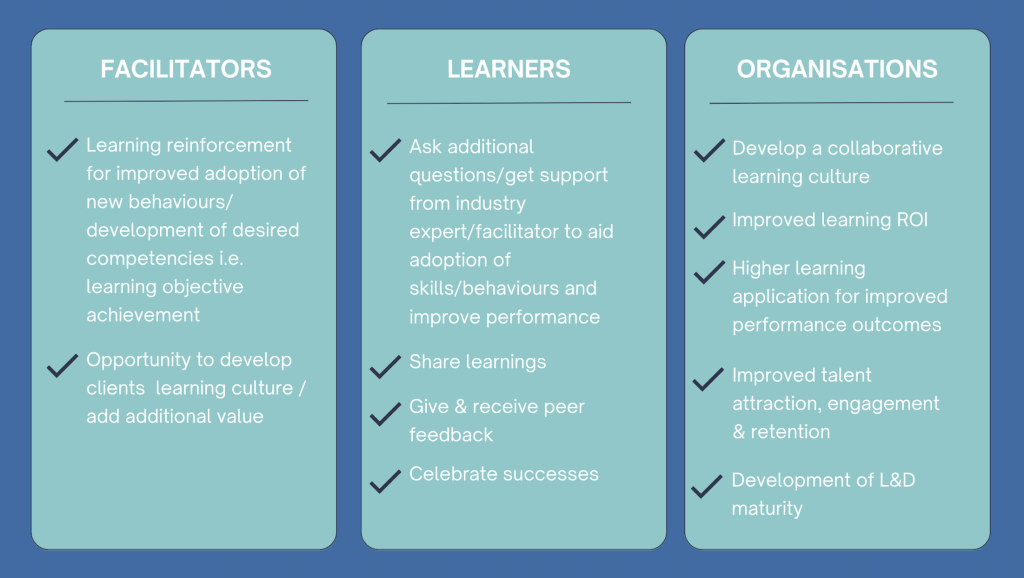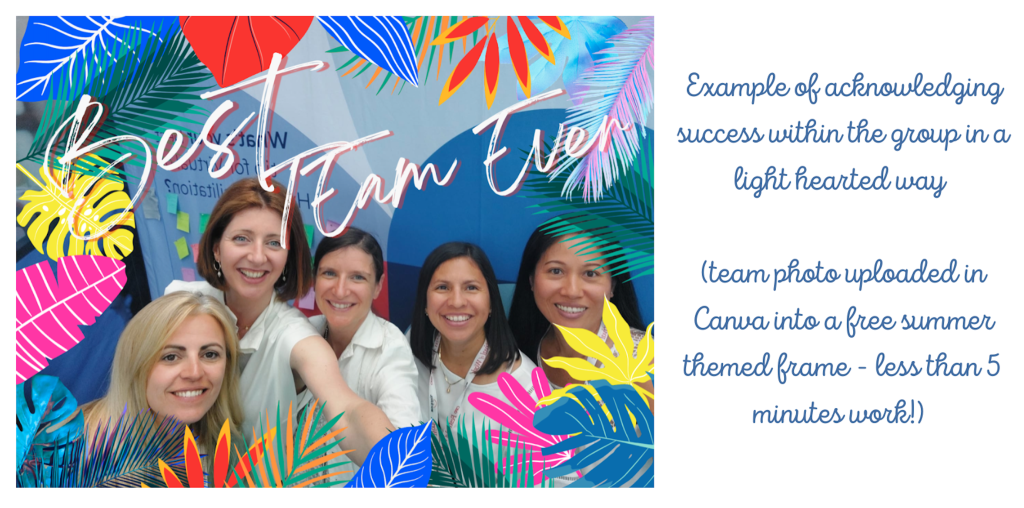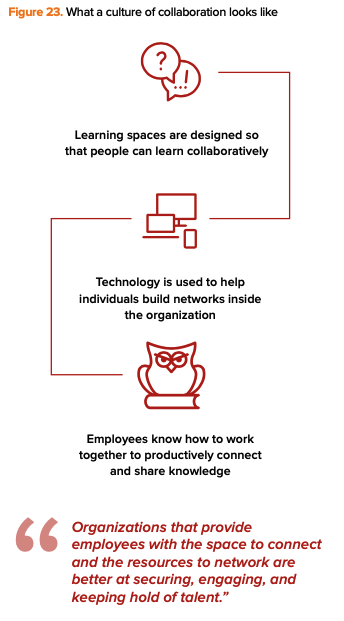
Having explored the role of transliteracy in virtual training mastery, we’re now delving into one particularly important aspect of this – learning community facilitation.
An essential trait of mature, high performing learning cultures, collaboration is key to creating a modern and personalised learning environment.
In research from MindTools, employees were asked about the most useful approaches in solving job related challenges, and the two highest ranked were working in collaboration with other team members, and support from colleagues. Yet only 20% of organisations have the inhouse L&D capabilities to facilitate social/collaborative learning (MindTools for Business Annual L&D Benchmark Report 2022 p21-23).
WHY ARE LEARNING COMMUNITIES SO IMPORTANT?
Group collaboration has always been an effective way of reinforcing and embedding classroom learning, but hybrid has certainly accentuated the need for collaboration between remote workers, and technological advancements provided a wealth of options to enable this.
As virtual and hybrid facilitators we need to ensure we have the knowledge and skills to design for, and leverage these capabilities within our learning journeys. And this is a forum where we can really reinforce the development and embedding of more complex competencies and soft skills through personalised feedback, group coaching and expert advice that’s just not possible with AI and e-learning.
Learning communities offer benefits for all stakeholders when done well:

5 TIPS FOR LEARNING COMMUNITY FACILITATION
1. Create a safe space: In week 5 ‘Getting Learners On Board – Building Engagement through Trust & Relevance’ we talked about the importance of trust, and shared specific considerations for establishing it within the virtual classroom. This is also the foundation of community management beyond the live sessions – the creation of a psychologically safe and inclusive space where learners feel comfortable about how to engage, and in the knowledge that their contributions will be heard and valued by the facilitator and their peers. How do you go about this?
- Show and share details on what platform will be used – providing links, login details, and ‘how to’ user guides
- Walk learners through the ‘rules of engagement’ about how they can use the space for example:
- Explain the filing structure and/or how they can easily find content
- Sharing guidelines for how they can share useful and relevant content
- Outline the digital etiquette rules – what behaviour is and isn’t acceptable
2. Facilitate valuable personalised feedback: The purpose of a community is to enable peer to peer learning reinforcement, not always to be the one to provide feedback. So monitor the community to ensure feedback is being given to all contributions, that it is constructive, and enrich or expand it where necessary with additional comments and curated content.
3. Celebrate successes: As we know, positive reinforcement reinforces behaviours, so encourage your learners to use the community not just for challenges, but also to share and celebrate achievements. Whether it’s fun visuals, screen captures, video, music, certificates, badges – acknowledge when a learner gets a positive outcome from applying their new skill.

4. Use Assignments & Learning Journals to encourage engagement: I often get asked by trainers how they can differentiate introverted learners who naturally don’t engage as much, versus disengaged or struggling learners. This is where I recommend things like mandatory assignments and learning journals. I ask learners to return a learning journal after every session (especially when they’ve missed one, to motivate them to catch up with the recording). They’re always sent to me privately to maintain privacy and encourage honesty about difficulties and challenges. I thank participants for sending them, read every single one, and comment or feedback as appropriate. And if someone asks a question that’s relevant for everyone I respond in the community without disclosing who asked.
5. Set rules for engagement: It’s always good to clarify what your expectations are in any community when it comes to important topics such as privacy, availability, and online behaviour. So for example:
- Privacy – to maintain yours and your learners privacy in the virtual classroom and community it’s important to make sure everyone understands:
- Not to share personal information and data
- Not posting anything that could hurt others or have a negative effect (constructive feedback only!)
- When recording live sessions, clearly communicate how and where these videos will be shared
- Decide and communicate your policy on learners logging in from public connections in order to maintain community data security (most community platforms will be protected behind a firewall)
- Availability and response times – virtual learning and communities allow us to connect learners around the world in different time zones, but in this increasingly global and asynchronous working culture, it’s important as facilitator to establish your own hours of availability and response times, and to encourage learners to create their own peer to peer expectations around engagement. This helps prevent everyone feeling the need to be ‘always on’, and aids smooth interaction.
- Digital etiquette & behaviour – some of the rules I use in my learning communities are:
- Only constructive feedback to be shared
- Engage from position of trust and respect
- Cite sources
- No inappropriate material or language
- Privacy – to maintain yours and your learners privacy in the virtual classroom and community it’s important to make sure everyone understands:
I’m sure you have your own community management tips…we’d love to hear them! To share head over to LinkedIn to join the conversation
DESIGNING FOR COLLABORATION
Managing a community takes a little time, so this has to be factored into the facilitation work. But I highly recommend it because integrating learning communities into our design helps us deliver greater impact from our learning journeys, meet our clients learning objectives, and help them take another step towards a high performing learning culture. As MindTools highlight, this is critical in securing, engaging and retaining talent.

Source: MTB Annual Report – MindTools for Business Annual L&D Benchmark Report 2022
NEXT TIME..
Join us next week for our penultimate blog on how we can evaluate and measure impact!
To make sure you don’t miss out on the last two instalments of this Virtual Learning Mastery: Designing for Impact series, sign up for our fortnightly roundup below, and follow us on LinkedIn
Further posts
-
Contact SyncSkills
- +44(0) 1737 779480
- hello@syncskills.net
Sign up to our dedicated Virtual Learning Master fortnightly newsletter here:
We do not spam and you can unsubscribe at your convenience.


